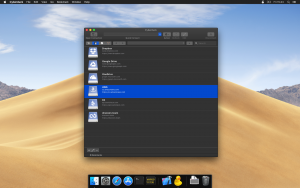

- #MOUNTAIN DUCK DROPBOX SUPPORT UPDATE#
- #MOUNTAIN DUCK DROPBOX SUPPORT PORTABLE#
- #MOUNTAIN DUCK DROPBOX SUPPORT WINDOWS#
If you want to run your backup processes from a Windows PC, Bvckup 2 is a slick, fast option for just $20. I have more than 100TB on Google Drive, so I’d say this works well! I can be up and running from a new machine very quickly and have several layers of backup so even if there’s a major problem with one cloud vendor, I have effectively a mirror in another one, as well as local copies.

#MOUNTAIN DUCK DROPBOX SUPPORT UPDATE#
I should update this section once I’ve moved to Google Workspace which I’ll have to do by January 2022. Of course this may change at any moment, but Google has closed their eyes on this for years. However, in practice the limit on smaller account is not enforced, I and many other people have several TBs on single-user G Suite accounts. Google Drive. Google’s G Suite Business has a plan for $10/user/month with 1TB of storage, and in theory you need to have at least 5 users to get unlimited storage. Dropbox Smart Sync (formerly known as Project Infinity).This also works well, but I’m not using it as my primary storage solution for work files as it doesn’t work in Windows Server, which I regularly use on an Azure virtual machine. Google Drive File Stream (for G Suite customers only).OneDrive Files On-Demand (this is a reintroduction of the discontinued “smart files”).Placeholder files/links for hybrid storageĪfter some back and forth, the big cloud storage vendors have all moved to implement “placeholder files” which are really local links to cloud-stored files that can be substituted with a local copy (think of it as a cache) of frequently-used files: This pushed me to look into third-party apps that let you mount cloud storage as a network drive and/or back up to one or several cloud storage providers among those that offer the most terabytes for the buck.ģ.5. In the distant past I used CrashPlan but their crap java client forced me to move away from that company.

The integration with SharePoint is also something I use on a daily basis for work.
#MOUNTAIN DUCK DROPBOX SUPPORT PORTABLE#
OneDrive already comes with Windows and as such is a good way to get a core toolkit of portable applications on any of your PCs.Google Drive is great to index, search and consult PDFs and MS Office files.To make files and portable applications available across devices, I’m pretty happy with Google Drive and OneDrive respectively: Wouldn’t it be nice to have more flexibility and use the cloud as if it was just another drive? That’s what we’re going to explore in this entry. This is a data retention policy and business model choice from the likes of Backblaze, not a technical limitation. īut what if you want to back up existing folders or network drives? Then you have “cold storage” solutions such as CrashPlan or BackBlaze, but they have their own hard-set constraints and perspective on how things should work that you have to adhere to.Īnd what if you want to extend your storage into the cloud, to store stuff that you are not going to keep around locally? That’s just how sync works by definition, while the backup-oriented services will eventually (some earlier than others) drop the files that they no longer see on your local system. You pretty much have to adapt your file organization to their way of thinking and use their client. not enterprise) has “traditionally” been associated with the concept of syncing a dedicated local folder with the cloud, because it’s the way desktop apps from DropBox, Google Drive, OneDrive and the likes work. Cloud storage for consumers and small businesses (i.e.


 0 kommentar(er)
0 kommentar(er)
